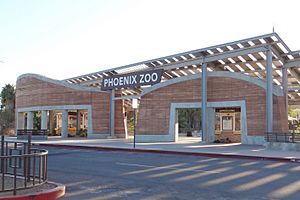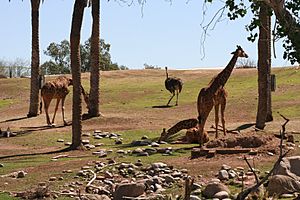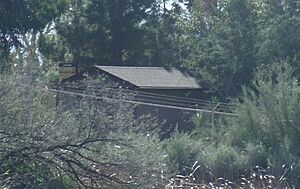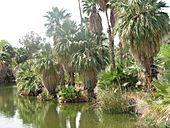Phoenix Zoo facts for kids

Zoo entrance (2014)
|
|
| Date opened | 1 November 1962 |
|---|---|
| Location | Papago Park, Phoenix, Arizona, United States |
| Land area | 125 acres (51 ha) |
| Coordinates | 33°27′09″N 111°56′57″W / 33.452485°N 111.949258°W |
| No. of animals | 3,000 |
| Memberships | AZA WAZA |
| Major exhibits | Monkey Village, Harmony Farm, Desert Lives, Stingray Bay, Forest of Uco, Orang-Hutan: "People of the Forest", Isle of the Tiger |
The Phoenix Zoo is a super cool place to visit in Phoenix, Arizona! It opened in 1962 and is the biggest privately owned, non-profit zoo in the United States. The zoo covers 125 acres of land in Papago Park and is home to over 1,400 animals. It's even known as a "Phoenix Point of Pride," which means it's a special landmark in the city.
The zoo has about 2.5 miles of walking trails for you to explore. It's split into four main areas, called "trails," each with a different theme. You can discover animals from the American Southwest, Africa, and rainforests. There's also a special Children's Trail with a fun petting zoo! From the very beginning, the Phoenix Zoo has cared deeply about protecting animals. It has helped save animals like the Arabian oryx from extinction.
Contents
Discovering the Phoenix Zoo's Story
The Phoenix Zoo started as a dream of Robert Maytag, who was part of the Maytag family. He wanted to open a zoo in Phoenix. Before him, people had talked about a zoo, but nothing ever happened.
Even though Robert Maytag sadly passed away before the zoo opened, it still welcomed its first visitors in November 1962. It was first called the "Maytag Zoo," but the next year, its name changed to "Phoenix Zoo" to connect it more with the city. The zoo was built on land that used to be a fish hatchery. This hatchery was built in the 1930s and was used until 1959. The Phoenix Zoo has always been a private, non-profit place, meaning it doesn't get money from the government to run every day.
The zoo grew a lot in the 1970s and 1980s. They added new animal homes, beautiful plants, and better places for visitors. During this time, they also created the four themed "trails" you can explore today. In 1998, the zoo opened Harmony Farm, which has farm animals and a petting zoo. Later, they added Desert Lives in 2000 and Monkey Village in 2004, where you can see many different monkeys. In 2006, Stingray Bay opened, letting visitors get close to aquatic animals. In 2009, two Komodo dragons joined the zoo family. Then, in 2011, a new orangutan exhibit called "Orang-Hutan: People of the Forest" opened.
Exploring the Zoo's Amazing Trails
The Phoenix Zoo has four main themed areas, or "trails," where you can see animals from different parts of the world. These are the Arizona Trail, the Africa Trail, the Tropics Trail, and the Discovery/Children's Trail.
The Arizona Trail: Desert Wonders
The Arizona Trail shows off the animals and plants that live right here in Arizona. You'll see famous saguaro cactus and animals like the coyote, collared peccary (also called a javelina), cougar, bobcat, raven, and the Mexican wolf. It's like taking a walk through the Sonoran Desert!
The Africa Trail: Wild Adventures
The Africa Trail is home to many popular animals from Africa. Here, you can spot African painted dogs, hamadryas baboons, mandrills, ostriches, white rhinos, Grévy's zebras, lions, cheetahs, and Reticulated and Masai giraffes. There's also a part called Desert Lives, where you can see bighorn sheep and Arabian oryx among natural rock formations.
The Tropics Trail: Rainforest Explorers
The Tropics Trail has two parts. One part goes along the lake and has a "Tropical Flights" aviary, where birds fly freely. You'll also see Bornean orangutans and common squirrel monkeys in "Monkey Village." The other part of the trail takes you past Komodo dragons in the "Land of the Dragons" exhibit, Asian elephants, jaguars, huge Galápagos tortoises and Aldabra giant tortoises, anteaters, and Sumatran tigers in the "Isle of the Tiger." This trail also has the Forest of Uco, a beautiful rainforest area with Andean bears.
The Children's Trail: Up Close and Friendly
The Children's Trail is perfect for younger visitors to get close to many smaller animals from all over the world. You might see emus, an ocelot, a caracal, siamang gibbons, and golden lion tamarins.
On this trail, you'll also find Harmony Farm. It has many farm animals, a petting zoo, and shows about farming. It's a great place to learn about farm life!
Ruby's House: A Special Place
The Hunt Bass Hatchery Caretaker's House was built in 1936 and is located inside the Phoenix Zoo. It used to be part of a fish hatchery. Today, this special house is known as "Ruby's House." It's named after Ruby, a famous painting elephant who lived at the zoo. Ruby's House is now a popular spot for weddings and other events.
More Fun at the Zoo
Besides the trails, the zoo has other cool attractions:
- Stingray Bay lets you gently touch cownose rays and southern stingrays in a special tank. bamboo sharks were also added later!
- An endangered species carousel is a fun ride for everyone.
- The Safari Train gives you a guided tour around the zoo.
- You can even enjoy camel rides and a Giraffe Encounter!
- ZooLights is a magical lighting show that happens every December.
Zoo Programs and Conservation Efforts
The zoo offers many programs for young people, like field trips, Night Camp, and a summer camp. They also have a "Zooteen" volunteer program for teenagers aged 13-17.
Since it opened, the Phoenix Zoo has worked hard to protect animals. They help animals that are endangered, give homes to animals that need a safe place, and rescue and help animals get better.
Saving Species: Reintroduction Programs
The Phoenix Zoo is famous for its work in bringing animals back from the edge of extinction. One of their biggest successes was with the Arabian oryx. These beautiful animals were almost gone from the wild. In the 1960s, the zoo started a special breeding program called "Operation Oryx." They brought a few oryx to the zoo to start a "World Herd."
This program was a huge success! The zoo celebrated its 225th Arabian oryx birth in 2002. Even though the Arabian oryx became extinct in the wild in 1972, thanks to efforts like the Phoenix Zoo's, they were released back into the wild starting in 1982. Many of the Arabian oryx living in the wild today have ancestors from the Phoenix Zoo!
Animal Sanctuary: A Safe Home
The zoo also provides a sanctuary for many animals that need a safe place to live. Some of these animals are part of breeding programs to help their species survive. Others might have retired from breeding or have special needs. The zoo makes sure these animals are comfortable and well-cared for.
After Ruby, the famous painting elephant, passed away in 1998, the zoo changed its elephant program. Now, they focus on helping elephants with special behavioral needs. For example, some elephants at the zoo might have been mistreated in the past or never learned how to get along with other elephants. The zoo gives them a loving home and helps them feel safe.
Rescue and Rehabilitation: Helping Animals Heal
The zoo also helps rescue and heal animals. For example, they treat California condors from the Grand Canyon area that have lead poisoning. These condors are one of the most endangered birds on Earth, and the zoo plays a vital role in their survival.
Ruby the Elephant: A Talented Artist
The Phoenix Zoo became famous worldwide because of an Asian elephant named Ruby. Ruby came to the zoo in 1973 when she was just a few months old. Her keeper noticed she liked to draw in the sand with sticks. So, he gave her a brush and paint!
Ruby quickly became known for her amazing paintings. People loved her art so much that they would pay hundreds of dollars for her original prints, and there was an 18-month waiting list to get one! Her paintings raised over $200,000 for the zoo.
Sadly, in 1997, Ruby became pregnant, but her calf died before it was born. Due to serious problems during surgery, Ruby had to be put to sleep. She is still remembered as a very special and talented elephant.
Zoo Improvements
The Phoenix Zoo is always working to make things better for the animals and visitors. They are raising money to update the zoo's buildings and exhibits. Many improvements are already happening to make the zoo even more amazing!
Images for kids










